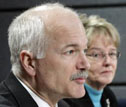Canadian sunset : abolishing cultural marxism in health care could make sense?
Feb 19th, 2006 | By L. Frank Bunting | Category: Key Current Issues Canada’s new federal health minister Tony Clement has rejected suggestions that the current surge of provincial government interest in public health care reform has been “emboldened by the election of a Tory government” in Ottawa.
Canada’s new federal health minister Tony Clement has rejected suggestions that the current surge of provincial government interest in public health care reform has been “emboldened by the election of a Tory government” in Ottawa.
But provocative fresh talk about allowing “a mix of private and public health-care delivery, as long as health care remains publicly funded and universally accessible,” in Quebec, BC, and Alberta, is the first big real public policy news since Stephen Harper’s minority Conservatives took office two weeks ago. (And the language about “a mix of private and public health-care delivery” here actually comes from the Harper election campaign platform.)
Jeffrey Simpson has just done a tidy job pulling the various health care reform threads of the past few weeks together, in a Globe and Mail column. He concludes that: “With three of Canada’s largest provinces ready to move from the status quo, and a Health Minister, Tony Clement, being a supporter of private delivery, the stars, as they say, are aligning slowly for changes to our health-care system, away from the … public-only model.”
This could eventually prove one key down-on-the-ground outcome of the 2006 Canadian federal election, Mr. Clement’s current view notwithstanding. In some respects it is only a short stretch to say that it is also all about abolishing at least some of the Canadian “cultural marxism” that US right-wing theocracy theorist Paul Weyrich has lately criticized (if not quite in the senses Mr. Weyrich loves best). It could be the issue that tests the real capacities and limitations of Jack Layton’s sort-of surging federal New Democrats as well. And who knows? It may even finally result in a somewhat better public health care system in Canada.
The deep background on the aligning stars …
 New federal health minister Tony Clement no doubt had something of a point when he recently told journalists that “this kind of discussion [about health care reform] was inevitable regardless of who was prime minister.” Ironically enough, today’s provocative provincial government talk about policy evolution “away from the … public-only model” has ultimately been prompted by what Paul Weyrich sees as Canada’s liberal left-wing judiciary.
New federal health minister Tony Clement no doubt had something of a point when he recently told journalists that “this kind of discussion [about health care reform] was inevitable regardless of who was prime minister.” Ironically enough, today’s provocative provincial government talk about policy evolution “away from the … public-only model” has ultimately been prompted by what Paul Weyrich sees as Canada’s liberal left-wing judiciary.
Last June, when Canadian political junkies in most parts of the country were most focused on the parliamentary soap opera in Ottawa, the “Supreme Court of Canada ruled” that ” banning private insurance for a list of services ranging from MRI tests to cataract surgery was unconstitutional under the Quebec Charter of Rights, given that the public system has failed to guarantee patients access to those services in a timely way” (the so-called “Chaoulli decision”). This put Jean Charest’s (ostensibly Liberal) Quebec provincial government in the position of having to respond. And it has now responded, just as Stephen Harper’s new Conservative federal minority government has begun to settle into office. It has promised “to provide hip and knee replacements and cataract surgery within six months of a patient’s diagnosis and said it would pay for the procedures to be done at private clinics if necessary.”
 Meanwhile, far to the west, Gordon Campbell’s (also ostensibly Liberal) British Columbia provincial government gave its latest throne speech on Valentine’s Day 2006. And it said “it wants to lead a national debate on reforming and updating the Canada Health Act, which oversees medicare.” The speech also hinted at “a bigger role for the private sector in the delivery of health-care services.” And it raised such pointed questions as “Does it really matter to patients where or how they obtained their surgical treatment if it is paid for from public funds?”; “Why are we so afraid to look at mixed health-care delivery models, when other states in Europe and around the world have used them to produce better results for patients at lower cost to taxpayers?”; and “Why are we so quick to condemn any consideration of other systems as a slippery slope to an American-style system that none of us wants?”
Meanwhile, far to the west, Gordon Campbell’s (also ostensibly Liberal) British Columbia provincial government gave its latest throne speech on Valentine’s Day 2006. And it said “it wants to lead a national debate on reforming and updating the Canada Health Act, which oversees medicare.” The speech also hinted at “a bigger role for the private sector in the delivery of health-care services.” And it raised such pointed questions as “Does it really matter to patients where or how they obtained their surgical treatment if it is paid for from public funds?”; “Why are we so afraid to look at mixed health-care delivery models, when other states in Europe and around the world have used them to produce better results for patients at lower cost to taxpayers?”; and “Why are we so quick to condemn any consideration of other systems as a slippery slope to an American-style system that none of us wants?”
Meanwhile again, just on the other side of the mountains from BC, Alberta’s (still officially Progressive) Conservative provincial government under the always provocative Ralph Klein has been making similar noises about parallel judicious movement “away from the … public-only model,” ever since the Supreme Court’s Chaoulli decision late last spring. And, just to round the picture out, Dr. Brian Day from BC – “one of the country’s most outspoken proponents of private health care” – has been nominated by his peers as the next president of the Canadian Medical Association, subject to what is usually an automatic confirmation at a CMA conference this coming August.
The provincial health-care cost juggernaut …
 Wherever all this fresh talk about Canadian health care reform may lead, it is still very early days yet. Beyond M. Charest’s still somewhat fuzzy Quebec proposal, just what exact changes in Canada’s present public health care system may finally be involved remains very murky. What does seem clear enough is that a fresh and probably more-consequential-than-in-the-past debate on adjusting the private-public rules of the game now lies ahead.
Wherever all this fresh talk about Canadian health care reform may lead, it is still very early days yet. Beyond M. Charest’s still somewhat fuzzy Quebec proposal, just what exact changes in Canada’s present public health care system may finally be involved remains very murky. What does seem clear enough is that a fresh and probably more-consequential-than-in-the-past debate on adjusting the private-public rules of the game now lies ahead.
Even beyond the Chaoulli decision, it also increasingly seems clear, this debate is going to be driven by the dramatically increasing cost pressures that the present Canadian public health care system is putting on provincial government budgets. And this is very important. Canada does not really have one federal public “medicare” system. As a result of the federal-provincial division of powers in the Constitution Act 1867, it has 10 different provincial public health-care systems – operated by the provincial governments and only partially subsidized financially by the federal government in Ottawa, in exchange, as it were, for provincial conformity with a very general set of crosscountry standards regarding accessibility, coverage, portability, and so forth.
 Jeffrey Simpson’s recent Globe and Mail column on the subject captures just how dramatic the health care cost pressures on provincial governments are becoming, with an example from a recent briefing by the BC deputy minister of health. If “health-care costs kept rising by 8 per cent yearly, as they have, then by 2017 health would take 71 per cent of the province’s entire budget, up from 41 per cent today … Throw in the costs of education (another 28 per cent), she said, and all the other government programs would have to come from less than 1 per cent of the total provincial budget. That’s obviously untenable. If BC … could get yearly health-care spending increases down to, say, 5 per cent, then the system would take only about half of the provincial budget.”
Jeffrey Simpson’s recent Globe and Mail column on the subject captures just how dramatic the health care cost pressures on provincial governments are becoming, with an example from a recent briefing by the BC deputy minister of health. If “health-care costs kept rising by 8 per cent yearly, as they have, then by 2017 health would take 71 per cent of the province’s entire budget, up from 41 per cent today … Throw in the costs of education (another 28 per cent), she said, and all the other government programs would have to come from less than 1 per cent of the total provincial budget. That’s obviously untenable. If BC … could get yearly health-care spending increases down to, say, 5 per cent, then the system would take only about half of the provincial budget.”
In this context the main theoretical argument for more of “a mix of private and public health-care delivery, as long as health care remains publicly funded and universally accessible” is that in at least some strategic cases the private sector can deliver certain kinds of health care at a lower cost than the public sector. So if provincial governments in some cases pay for private delivery of health services rather than delivering these services themselves (so to speak), they will wind up saving money and reducing rising health care cost burdens on provincial government budgets.
 This may of course prove to be a quite slippery argument in practice, in various ways. Once you start to look at it closely, the real world of publicly funded health care in Canada is already rather complex. And, as Jeffrey Simpson also notes, the experience with “mixed health-care delivery models … in Europe,” does not suggest that any “magic bullets” or “miracles lie abroad.”
This may of course prove to be a quite slippery argument in practice, in various ways. Once you start to look at it closely, the real world of publicly funded health care in Canada is already rather complex. And, as Jeffrey Simpson also notes, the experience with “mixed health-care delivery models … in Europe,” does not suggest that any “magic bullets” or “miracles lie abroad.”
But public health care systems in other parts of the world do seem to have experimented lately with mixed public-private delivery models with some cost-saving success. Anyone who has paid attention to Canadian provincial budgets over the past quarter-century can appreciate that there is an increasingly urgent health care cost-pressure problem – which no amount of ideological rhetoric is going to be able to just wish away. The modern “service state” more generally is concentrated at the provincial level of government in Canada – for the same constitutional reasons as the narrower health care system. And even anyone mostly concerned about the broader constructive and creative role the democratic public sector can play in Canadian society has to be worried about the increasing extent to which health care expenditures are encroaching on the capacity of the public sector at large to deliver other key public services.
Defending the current cultural-marxist model to the last ditch … and Jack Layton’s NDP
 In a general way at least, what does now seem likely to change in Canadian health care policy over the next several years is the current sometimes mindless official attachment to what Jeffrey Simpson and others call the “Romanow commission” model of the present “Canadian status quo.” (After the latest and heretofore most influential federal commission on the subject, chaired by former Saskatchewan NDP premier Roy Romanow at the request of Jean Chretien. And where Saskatchewan under the NDP [and old CCF] was also the original birthplace of the general theory behind the cross-Canada network of 10 provincial public health care systems today.)
In a general way at least, what does now seem likely to change in Canadian health care policy over the next several years is the current sometimes mindless official attachment to what Jeffrey Simpson and others call the “Romanow commission” model of the present “Canadian status quo.” (After the latest and heretofore most influential federal commission on the subject, chaired by former Saskatchewan NDP premier Roy Romanow at the request of Jean Chretien. And where Saskatchewan under the NDP [and old CCF] was also the original birthplace of the general theory behind the cross-Canada network of 10 provincial public health care systems today.)
It may seem just too cute to borrow a leaf from the ideologically hostile book of Paul Weyrich here, and characterize the essential underlying assumptions of the Romanow Commission health care status quo in Canada as “cultural marxist.” But it is apt enough in some respects – and it does help dramatize the kind of change that is probably going to be rather aggressively debated in some quarters on largely ideological grounds for a while longer yet. The key cultural marxist assumption might be very roughly said to be that all forms of private financial involvement should be altogether minimized as much as humanly possible in the public health care system – in order to ensure that all Canadians are treated equally when it comes to their health care needs, and receive treatment based on need and not ability to pay.
 In fact this question is and has always been a matter of degree. There is already significant private involvement in health care in Canada – just as there is a much more extensive public health care system in the United States, for retired and low-income individuals, than most either Canadian or US public debate typically acknowledges. But for the moment in any case practically all this seems likely to remain just a nuance in the emerging new debate over private delivery of publicly funded health care services in Canada. Jack Layton’s federal New Democrats, e.g., have already shrewdly sensed what is blowing in the wind as early as this past fall. And they have toyed with the prospect of positioning themselves as the staunch last-ditch defenders of the Romanow Commission status quo, and its cultural marxist assumptions.
In fact this question is and has always been a matter of degree. There is already significant private involvement in health care in Canada – just as there is a much more extensive public health care system in the United States, for retired and low-income individuals, than most either Canadian or US public debate typically acknowledges. But for the moment in any case practically all this seems likely to remain just a nuance in the emerging new debate over private delivery of publicly funded health care services in Canada. Jack Layton’s federal New Democrats, e.g., have already shrewdly sensed what is blowing in the wind as early as this past fall. And they have toyed with the prospect of positioning themselves as the staunch last-ditch defenders of the Romanow Commission status quo, and its cultural marxist assumptions.
From a broader progressive point of view, it is also quite arguable that if Canada’s theoretically most progressive political party continues to follow this path, it will ironically only push the final outcome of the new health care reform debate further to the right than it would otherwise be, in what is still a majority blue-state country, in wider North American terms. (Much as, in standing so aggressively for a purer progressive vision than the always opportunistic Liberals in the 2006 election just past, the New Democrats ironically helped elect a Conservative instead of a Liberal minority government – and one led by a new prime minister with a clear enough past as something of a zealous neo-con ideologue at that.)
 Moreover, in the present circumstances of Canadian society, in both official languages and across the country, it now seems at least quite arguable that some strategic mix of public and private delivery of publicly funded health care services might ensure that all Canadians are treated equally when it comes to their health care needs, and receive treatment based on need and not ability to pay, rather better than policies which aggressively try to minimize all private involvement. It is also no doubt important to carry on the fight against the kind of critique of “cultural marxism” identified with such North American figures as Paul Weyrich (who has also apparently urged at some point that the USA today would be better off if the South had won the Civil War). But even in Canada it ought to be increasingly clear as well that times have changed a lot since the 1930s Regina Manifesto that gave birth to the modern Canadian social democratic movement, for which the NDP now carries the noble torch.
Moreover, in the present circumstances of Canadian society, in both official languages and across the country, it now seems at least quite arguable that some strategic mix of public and private delivery of publicly funded health care services might ensure that all Canadians are treated equally when it comes to their health care needs, and receive treatment based on need and not ability to pay, rather better than policies which aggressively try to minimize all private involvement. It is also no doubt important to carry on the fight against the kind of critique of “cultural marxism” identified with such North American figures as Paul Weyrich (who has also apparently urged at some point that the USA today would be better off if the South had won the Civil War). But even in Canada it ought to be increasingly clear as well that times have changed a lot since the 1930s Regina Manifesto that gave birth to the modern Canadian social democratic movement, for which the NDP now carries the noble torch.
Whether Jack Layton’s New Democrats can finally contribute to the emerging new health care reform debate in innovative and practically constructive (and even shrewdly pragmatic) ways – that go beyond a mindless, knee-jerk ideological defence of the present Romanow Commission status quo, may ultimately have a great deal to do with just how much real progressive ground Canadian politics is or is not going to gain over the next several years (and perhaps still further into the much longer-term future too?).

